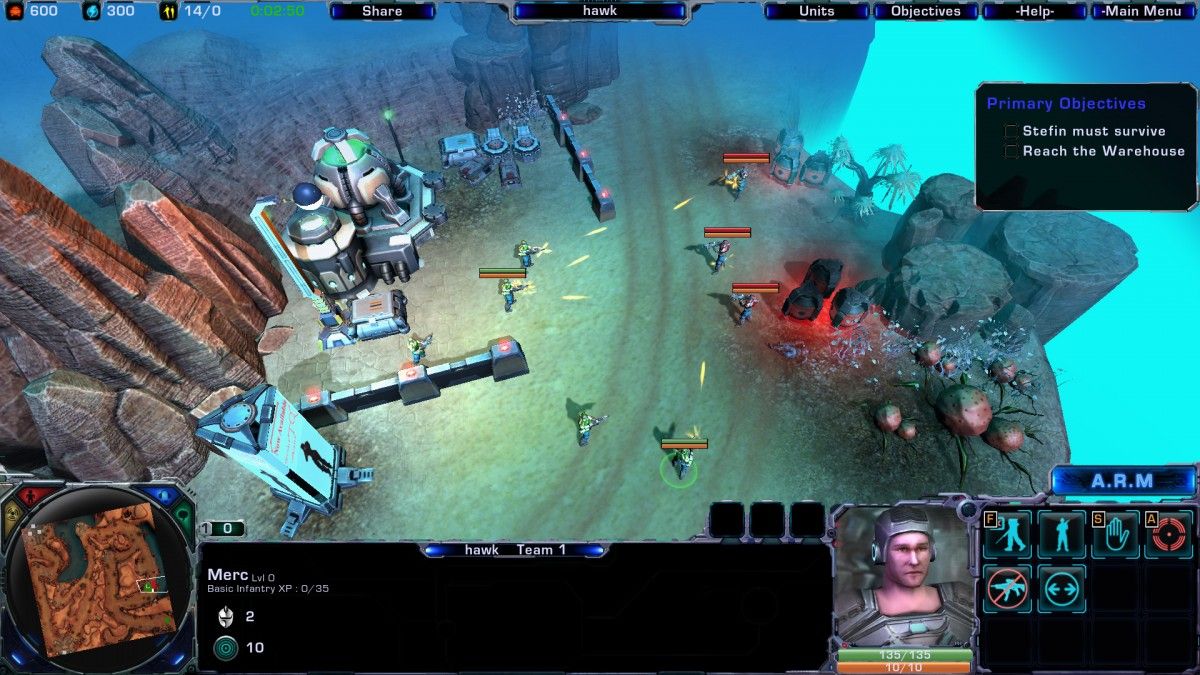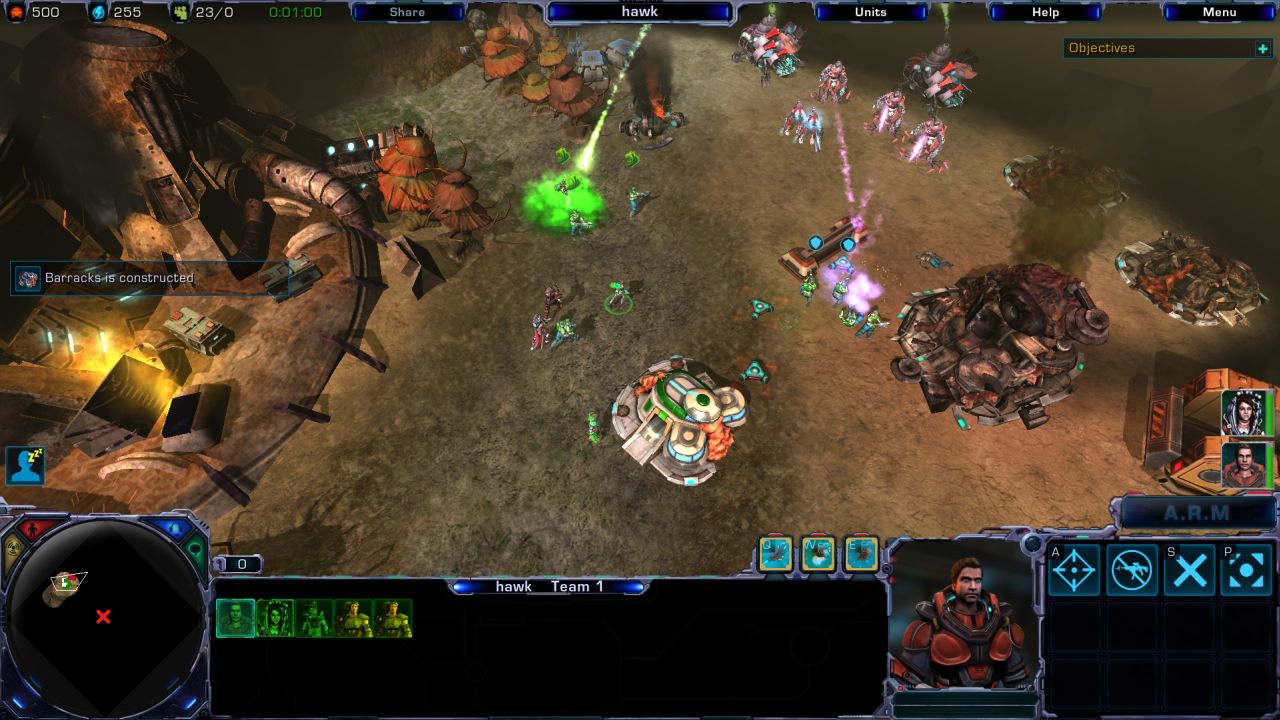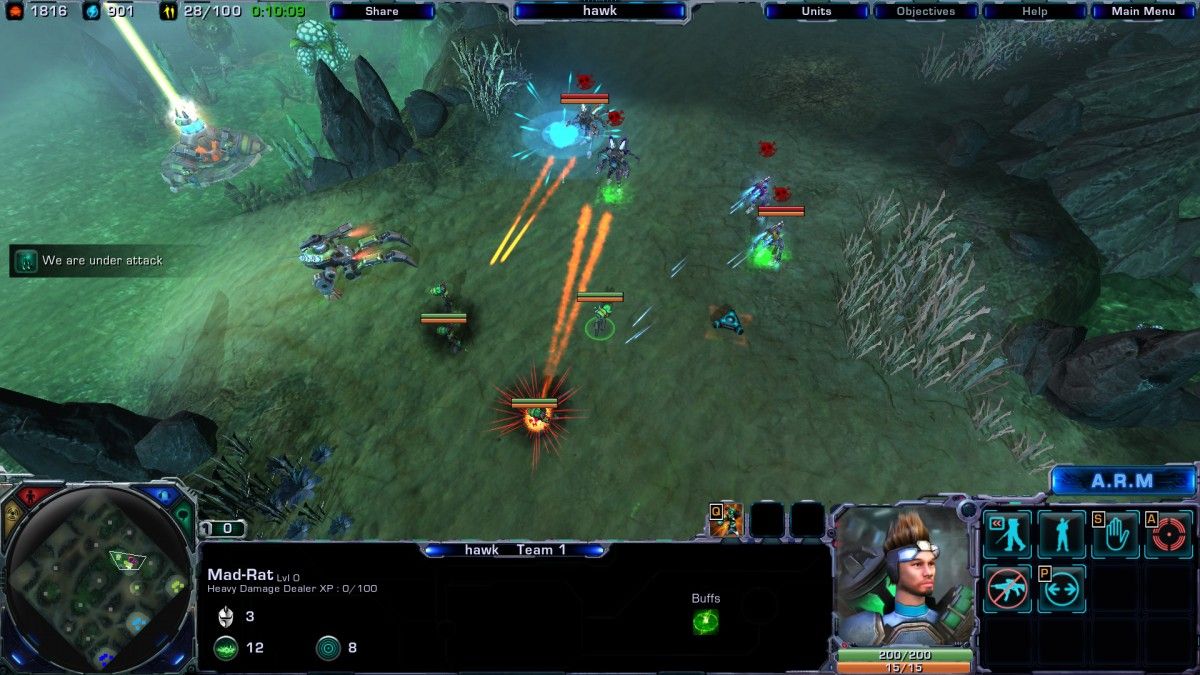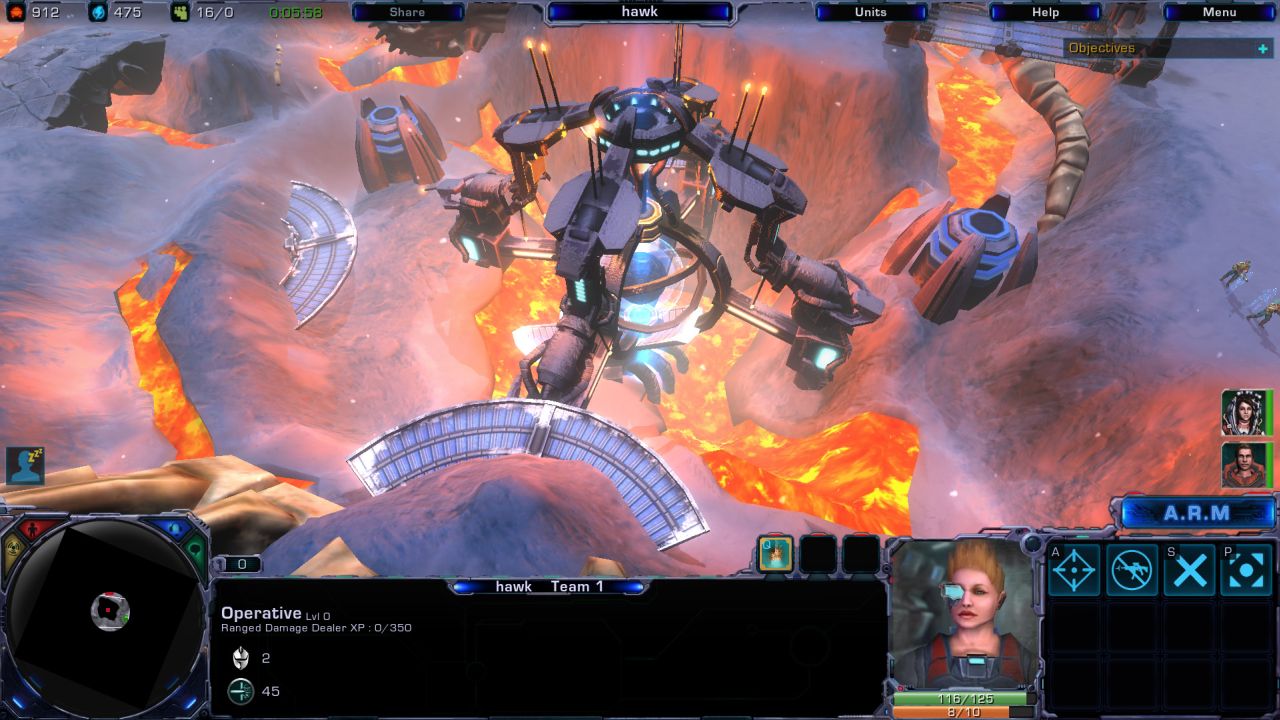Tryst Review
On one of your free weekends, when you’re double checking your list of “Childhood experiences everyone should have” (and if you don’t have such a list, get writing!), make sure you have a check mark next to “Play with Plastic Soldiers”. Action figures don’t count, mind you, but ‘Cowboys and Indians’ or even a solid set of Lego figurines will do just as well. Plastic army playtime is such a fundamental part of play that a few years ago when one of my roommates casually dropped a five dollar bag of plastic soldiers in my dorm’s common room, it was surprising how many of my college buddies put down their Gamecube controllers to fiddle with their small armies. The point is that there’s no more classic arena of play than making your own small army. Similarly, there’s no more classic conflict of play than humans versus aliens. Smack these two facts together, and the new RTS game Tryst is built on rock solid ground.

Tryst has all the basic features that you’d expect of a good RTS: well-balanced tech trees, a straightforward resource system, varied terrain maps, etc. The game’s resource management is capture-node based, with a two-type resource system of Ore and Energy (or as I like to call them, “Not minerals” and “Not vespene gas”). The node-based resource system greatly simplifies that icky economy side of the macro strategy in the game, and your production facilities produce quickly enough that you’d only build more than one of the same building if you were going to dedicate your entire army around one unit category. As much as I am a great fan of familiar Warcraft and Starcraft macro mechanics, having capture points serve as your source of income is quickly becoming a standard in the modern RTS for some obvious reasons: it lets you get right into the thick of gameplay, making your individual battles meaningful even in early stages of the game.
As a work of fiction, Tryst sadly doesn’t have much to offer. The world-building seems fairly standard, generic science fiction, with only the Zali aliens having much of a unique flavor. One area where the game admittedly makes up for this somewhat is in the fact that the humans have a stunning array of accents: Russian, Jamaican, British, and I thought I even heard some cockney thrown in. Thankfully, the voice acting is spot on, and the unit lines are delivered with great gusto and character that never gets old. The story in campaign mode is passable, but obviously made without great effort, and the unit designs themselves are something of a mixed bag: although your larger ships and vehicles are unique enough to pick out easily and distinguish at a distance, your ground troops often look so similar that it’s difficult to tell them apart and almost not worth the effort to try to specifically select your healers and spell casters. Although the Zali have some interesting unit designs and portraits, the human character portraits are mostly zombified blank-faced models. I would’ve preferred 2D portraits, as long as they had some character.

Tied into the fiction, the campaign in Tryst is difficult to enjoy due to what seemed like a multitude of small annoyances. There’s no difficulty setting and no way to skip cutscenes or dialogue. Several of the missions include the classic requirement of keeping your heroes alive, but in some of them (particularly one small-party mission where heroes composed your entire army), this was so troublesome that the only way to progress was by “save scumming” or hiding your heroes away from the action instead of being able to make use of their abilities. The scripting in the campaign seemed a little buggy, and frequently dialogue would be introduced mid-sentence, or cut off awkwardly. One gameplay aspect specifically advertised by the game that was at least entertaining was a focus on objective choice during the campaign missions. Most missions will offer you either competing goals or enough secondary objectives that it’s a difficult challenge to get them all. It gives the campaign good replay value.
The music provided by Daniel Sadowski is appropriately reserved and allows for focus on the game, but is somewhat marred by a poorly-implemented dynamic music system, which triggers the transition from ‘combat music’ to ‘safe music’ far too easily and quickly. Even if your army runs into a single wandering enemy unit, the starting music will fade out into the new key for a few seconds, and then immediately fade back into the old after your one-shot dispatch. Sound design also seemed to have some minor rough spots (the Zali language seems mostly just human speech run through a random transform, and some of the alert sounds are outright jarring), but for the most part is able to provide good distinguishing associations between weapon and unit types, which is the most important job for sound in any RTS title.
The mentioned shortcomings aren’t to say that Tryst doesn’t have its fair share of innovations. First and foremost in the arsenal is A.R.M, the unit customization and upgradeability mechanic that gives the game its true depth. Unlike most RTS games, which might have one or two major upgrades per unit type, Tryst goes full throttle by giving you a full seven or eight possible upgrades for each. Increased health, personal shields, longer range, and a healthy dose of special abilities and spells all give you unseen ability to mold your army the way you like. If you favor your Mad Rats, you can spend your money on making them beefier and give them a special attack. If you’re more of a Javelin fan, you can give them recharging shields and boost their range. The limiting factor in these upgrades is that each unit type is allowed only three upgrades (on from each tier), so you can’t simply go haywire on your opening units and turn them into supermen.

The A.R.M. system’s strength is that it promises an infinite variety of gameplay. Players can’t become too complacent with memorizing counters and build orders because this time around those enemy mercenaries might just pack a much bigger punch than they did in your game ten minutes ago. This also means that Tryst’s metagame has an entire level of complexity beyond simple unit choice: you could spend quite a bit of time trying out different combinations of upgrades on only your starting two or three units. In theory this could cause trouble down the road: dozens of possible unit combinations multiplied by dozens of individual upgrade permutations means that there’s no way the folks at Blue Giant could have thoroughly tested all possibilities against overpowered builds. If the game catches on and because popular, it’s possible that there are particularly nasty configurations that dominate the multiplayer landscape on their discovery. That said, there don’t seem to be any particular problems in that area right now.
Another innovation with a few intriguing possibilities is the energy system. Spells in Tryst generally don’t have mana costs, relying on cooldowns for balance, but every unit require energy in order to fire its weapons, and this energy can be depleted in combat, then regained by gathering drops from fallen enemies. It’s a cool idea on paper, but in my playthrough I never actually found any gameplay value added by the feature.

The game isn’t currently popular enough to have a thriving online community, but all the basic multiplayer elements are there. A handy rating system lets you gauge your own skill against your opponents, and although the after-game data is presented merely as a list of numbers (what, after all, does a score of “130” mean on my resources?); it’s always nice to be able to look over your game after a loss and try to learn from your mistakes. A quick match feature is sorely missed, but it doesn’t take all that much effort to simply start your own public game and wait for someone to manually join. The game includes the smart but niche feature of having a computer AI instantly take over for any dropped player. This seems like an obvious step to make in the RTS genre, although how the game decides on the difficulty level of the AI is a mystery; imagine the nasty surprise you’d get if your tenderfoot opponent is suddenly replaced with a terrifying god-mode computer mastermind.
Tryst isn’t really trying to be groundbreaking and without a good core of fundamental gameplay and overall polish, there sadly isn’t much to recommend the game. The A.R.M. system is unique and holds great promise for the game, but lackluster controls and some questionable design decisions make it difficult to really enjoy customizing your units. It’s simply too difficult to select and control your spell casters to make them useful in combat, and for the moment the multiplayer world is split simply between those who have a basic understanding of the game and those who are newcomers. The game isn’t held back by any particular flaw, but to make up for it, it feels as if just about every aspect of the game is lacking polish. The tutorials are… alright. The online reference is… underwhelming (one would think that Blue Giant would finish the FAQ and the Wiki before releasing the game!). The RTS genre isn’t exactly bursting with new options these days, and maybe Tryst will satisfy your fix for the genre, but if you’re looking for an engaging strategy experience, you might want to wait on this one.
